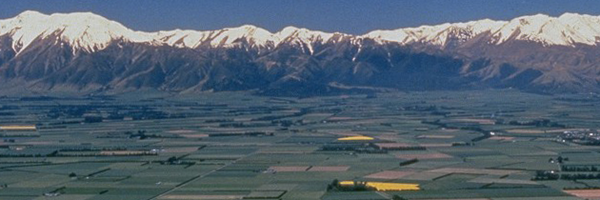
I gave a few talks at New Zealand's equivalent to the Cereals Event this week - The FAR CROPS Expo, held near Chertsey on the South Island. It was very difficult to prepare the talks because of recent events. The options were, should I excessively gloat about the most recent rugby result or maintain a dignified silence? After a lot of careful consideration I adopted the latter option. The audiences did the same, there was no mention of rugby.
As you know, NZ wheat yields can be very high. I was in a paddock (field) yesterday which yielded around 17.5 t/ha last season. The crop was irrigated, part of the approach that is taken to trap all the solar radiation that they receive during the critical growth stages of wheat. In fact their success can be directly attributed to trapping as much solar radiation as possible by adopting European long season wheat varieties, earlier sowing, disease control and irrigation. The farmers who have been adopting optimum practice for some time now feel that they are beginning to see a levelling off of yields and the annual variations they see can be directly attributed to the amount of solar radiation received during grain fill.
The weather over the last week has been extremely variable. This is not surprising when it is considered that NZ is comprised of two small islands in a big ocean. On the day of the event the much vaunted North Westerly blew with a vengeance. This wind is from the direction of Australia and is hot and dry. It was very difficult to stand at the plots and speak but I was informed that it could have been an awful lot worse. The potential transpiration for that day was estimated to be between 6-7 mm. Farmers quoted 1988 when a North Westerly blew for weeks and completely dried out the cereal crops on the lighter land, resulting in extremely low yields. So it is not surprising that irrigation is a great asset in such a climate.
Before this week the weather has been wetter than average and so the irrigators have only just been switched on. Wheat is at the flowering stage and the crops look magnificent. It could be a very good year if there is sufficient radiation from now on.
I have been on familiar territory on many aspects of wheat production over here. It is easy to pick out Oakley in the untreated variety trials, smothered in yellow rust. What is slightly different is that the amount of yellow rust on Claire is approaching that on Oakley. Claire has been very susceptible to yellow rust for the last six years over here. The tools to control diseases are fairly similar; Seguris is on the market with the SDHIs bixafen (in Aviator) and fluxapyroxad (in Adexar) in the final year of development. What is slightly different is that isopyrazam (which is mixed with epoxiconazole in Seguris) is available alone as Seguris Flexi. This may be because Seguris Flexi is used is herbage seed production. I may return to this in a later blog.
Today is cold (a maximum of 10 degrees Celsius) and wet. Not good conditions for the barbecue I'm attending at lunchtime. It's comforting to know that the English are not alone in having barbecues in the rain.
